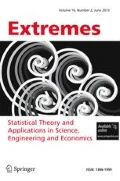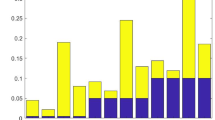Abstract
Exciting information for risk and investment analysis is obtained from an exceptionally large and automatically filtered high frequency data set containing all the forex quote prices on Reuters during a ten-year period. It is shown how the high frequency data improve the efficiency of the tail risk cum loss estimates. We demonstrate theoretically and empirically that the heavy tail feature of foreign exchange rate returns implies that position limits for traders calculated under the industry standard normal model are either not prudent enough, or are overly conservative depending on the time horizon.
Similar content being viewed by others
References
Baillie, R.T. and Dacorogna, M.M., “Special issue on high frequency data,” Journal of Empirical Finance 4, 69–293, (1997).
Baillie, R.T. and McMahon, P.C., The Foreign Exchange Market, Cambridge University Press, Cambridge, 1989.
Boothe, P. and Glassman, D., “The statistical distribution of exchange rates, empirical evidence and economic implications,” Journal of International Economics 22, 297–319, (1987).
Dacorogna, M.M., Müller, U.A., Nagler, R.J., Olsen, R.B., and Pictet, O.V., “A geographical model for the daily and weekly seasonal volatility in the FX market,” Journal of International Money and Finance 12(4), 413–438, (1993).
Daniclsson, J., de Haan, L, Peng, L., and de Vries, C.G., “Using a bootstrap method to choose the sample fraction in tail index estimation,” Journal of Multivariate Analysis 76, 226–248, (2001).
Danielsson, J. and de Vries, C.G., “Beyond the sample: Extreme quantile and probability estimation with applications to financial data,” Tinbergen Institute, discussion paper, T198-016/2, 1998.
De Haan, L., Jansen, D.W., Koedijk, K.G., and De Vries, C.G., “Safety first portfolio selection, extreme value theory and long run asset risks” In: J. Galambos, J. Lechner, and E. Simiu, (eds), Extreme Value Theory and Applications, Kluwer, Dordrecht, 471–488, (1994).
De Haan, L., Resnick, S.I., Rootzén, H., and De Vries, C.G., “Extremal behavior of solutions to a stochastic difference equation with application to ARCH processes,” Stochastic Processes and their Applications 32, 213–224, (1989).
Dowd, K., Beyond Value at Risk, Wiley, Chichester, 1998.
Drees, H. and Kaufman, E., “Selection of optimal sample fraction in univariate extreme value estimation,” Stochastic Processes and their Applications 75, 149–172, (1998).
Fama, E.F. and Miller, M.H., The Theory of Finance, Dryden Press, Hinsdale, 1972.
Feller, W., An Introduction to Probability Theory and its Applications, Volume II, John Wiley, New York, (second edition), 1971.
Geluk, J., de Haan, L., Resnick, S., and Starica, C., “Second order regular variation, convolution, and the central limit theorem,” Stochastic Processes and their Applications 69, 139–159, (1997).
Goldie, C.M. and Smith, R.L., “Slow variation with remainder: Theory and applications,” Quarterly Journal of Mathematics, Oxford 2nd series, 38, 45–71, (1987).
Goldie, C.M., “Implicit renewal theory and tails of solutions of random equations,” The Annals of Applied Probability 1, 126–166, (1991).
Groenendijk, P.A., Lucas, A., and de Vries, C.G., “A note on the relationship between GARCH and symmetric stable processes,” Journal of Empirical Finance 2, 253–264, (1995).
Hall, P., “On some simple estimates of an exponent of regular variation,” Journal of the Royal Statistical Society Series B, 44, 37–42, (1982).
Hall, P., “Using the bootstrap to estimate mean square error and select smoothing parameter in nonparametric problem,” Journal of Multivariate Analysis 32, 177–203, (1990).
Hill, B.M., “A simple general approach to inference about the tail of a distribution,” The Annals of Statistics 19, 1547–1569, (1975).
Hols, M.C. and De Vries, C.G., “The limiting distributions of extremal exchange rate returns,” Journal of Applied Econometrics 6, 287–302, (1991).
Leadbetter, M.R., Lindgren, G., and Rootzén, H. Extremes and Related Properties of Random Sequences and Processes, Springer-Verlag, Berlin, 1983.
Müller, U.A., Dacorogna, M.M., Olsen, R.B., Pictet, O.V., Schwarz, M., and Morgenegg, C., “Statistical study of foreign exchange rates, empirical evidence of a price change scaling law, and intraday analysis,” Journal of Banking and Finance 14, 1189–1208, (1990).
Stahl, G., “Three cheers,” Risk 10, 67–69, (1997).
Author information
Authors and Affiliations
Rights and permissions
About this article
Cite this article
Dacorogna, M.M., Müller, U.A., Pictet, O.V. et al. Extremal Forex Returns in Extremely Large Data Sets. Extremes 4, 105–127 (2001). https://doi.org/10.1023/A:1013917009089
Issue Date:
DOI: https://doi.org/10.1023/A:1013917009089




